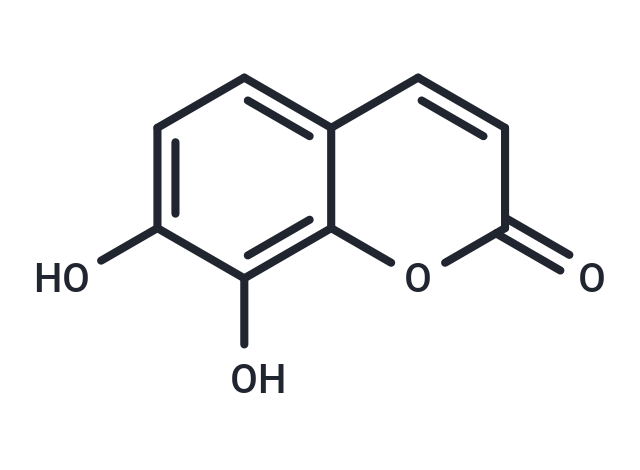Shopping Cart
- Remove All
 Your shopping cart is currently empty
Your shopping cart is currently empty

Daphnetin (7,8-Dihydroxycoumarin), a natural coumarin derivative, is a protein kinase inhibitor with inhibitory for EGFR (IC50: 7.67 μM), PKA (IC50: 9.33 μM), and PKC (IC50: 25.01 μM), also exhibit anti-oxidant and anti-inflammatory activities.

| Pack Size | Price | Availability | Quantity |
|---|---|---|---|
| 10 mg | $43 | In Stock | |
| 25 mg | $87 | In Stock | |
| 50 mg | $169 | In Stock | |
| 100 mg | $256 | In Stock | |
| 1 mL x 10 mM (in DMSO) | $47 | In Stock |
| Description | Daphnetin (7,8-Dihydroxycoumarin), a natural coumarin derivative, is a protein kinase inhibitor with inhibitory for EGFR (IC50: 7.67 μM), PKA (IC50: 9.33 μM), and PKC (IC50: 25.01 μM), also exhibit anti-oxidant and anti-inflammatory activities. |
| Targets&IC50 | EGFR:7.67 μM, PKC:25.01 μM, PKA:9.33 μM |
| In vitro | In water maze and forced swimming tests, Daphnetin (2-8 mg/kg) significantly improved the performance of stressed mice. At a dosage of 140 mg/kg, Daphnetin was able to reduce uterine weight by 39.5%. Additionally, Daphnetin markedly prolonged the survival time of mice infected with P. yoelii. |
| In vivo | Daphnetin, at concentrations between 25-40 μM, achieves a 50% inhibition rate against the incorporation of hypoxanthine induced by malignant malaria parasites. At a higher concentration of 50 μM, Daphnetin significantly reduces the levels of cyclin D1. It counteracts the reduction in cell viability caused by dexamethasone, which affects cortical neurons, in a dose-dependent manner. Daphnetin also inhibits the activity of endogenous or recombinant TaPRK in a specific, dose-dependent way. Moreover, it effectively inhibits tyrosine phosphorylation of exogenous substrates catalyzed by the epidermal growth factor receptor, in addition to inhibiting the activity of PKA and PKC. Treatment with Daphnetin for 24 hours suppresses the growth of the human cancer cell line MCF-7, which responds to estrogen (IC50: 73 μM), and inhibits the ERK1/ERK2 mitogenic signaling pathway. |
| Kinase Assay | Assay of protein kinase C (PKC) and cAMP-dependent protein kinase (PKA) activities.: PKC and PKA activities are detected. Briefly, 5 mL of PKC or PKA is mixed with 5 mL of lipid preparation containing 100 mM phorbol 12-myristate 13-acetate, 2.8 mg/mL phosphatidyl serine, and Triton X-100 mixed micelles for PKC assay or 5 mL of 40 mM cAMP in 50 mM Tris-HCl, pH 7.5, for PKA assay, and 5 mL of daphnetin. The reaction is started by adding 10 mL of PKC substrate solution containing 250 mM acetylated myelin basic protein, 100 mM ATP, 5 mM CaCl2, 10 mM MgCl2, 20 mM Tris-HCl, pH 7.5, or 10 mL of PKA substrate solution containing 200 mM Kemptide, 400 mM ATP, 40 mM MgCl2, 1 mg/mL BSA, 50 mM Tris-HCl, pH 7.5, and 20-25 mCi/mL[g-32P] ATP. After incubation at 25 °C for 5 minutes, 20 mL of each mixture is spotted on a piece of phosphocellulose disc which is immediately put into 1% H3PO4. After free [g-32P] ATP on the discs is removed, the peptide-incorporated 32P on the discs is counted in a scintillation counte |
| Cell Research | The cytostatic effect of Daphnetin tested on the MCF-7 tumor cells is estimated using the microculture MTT assay. The assay is based on the reduction of soluble tetrazolium salt by mitochondria of viable cells. The reduced product, an insoluble purple-colored formazan, is dissolved in dimethyl sulfoxide and measured spectrophotometrically (570 nm). The amount of formazan formed is proportional to the number of viable cells. Cells (3 × 103) are seeded in each of the 96 microplate wells in a 200 μL medium containing the corresponding concentration of daphnetin. Daphnetin is tested at five concentrations (12.5 μM, 25 μM, 50 μM, 100 μM, 200 μM). After 24-hour, 48-hour, and 72-hour exposure, the percentage of proliferative inhibition of treated cells is estimated against the solvent-treated control cells (PI% = [(T/C) ? 1] × 100). PI = proliferation inhibition; T = treated, C = control. IC50 is calculated from the least square concentration-response regressions.(Only for Reference) |
| Alias | Daphnetol, 7,8-Dihydroxycoumarin |
| Molecular Weight | 178.14 |
| Formula | C9H6O4 |
| Cas No. | 486-35-1 |
| Smiles | Oc1ccc2ccc(=O)oc2c1O |
| Relative Density. | 1.563 g/cm3 |
| Storage | keep away from direct sunlight | Powder: -20°C for 3 years | In solvent: -80°C for 1 year | Shipping with blue ice. | |||||||||||||||||||||||||||||||||||
| Solubility Information | Ethanol: < 1 mg/mL (insoluble or slightly soluble) DMSO: 55 mg/mL (308.75 mM), Sonication is recommended. H2O: < 1 mg/mL (insoluble or slightly soluble) | |||||||||||||||||||||||||||||||||||
Solution Preparation Table | ||||||||||||||||||||||||||||||||||||
DMSO
| ||||||||||||||||||||||||||||||||||||

Copyright © 2015-2024 TargetMol Chemicals Inc. All Rights Reserved.